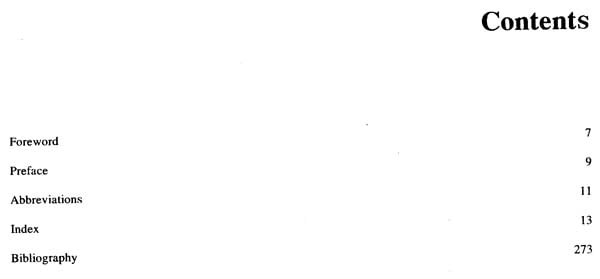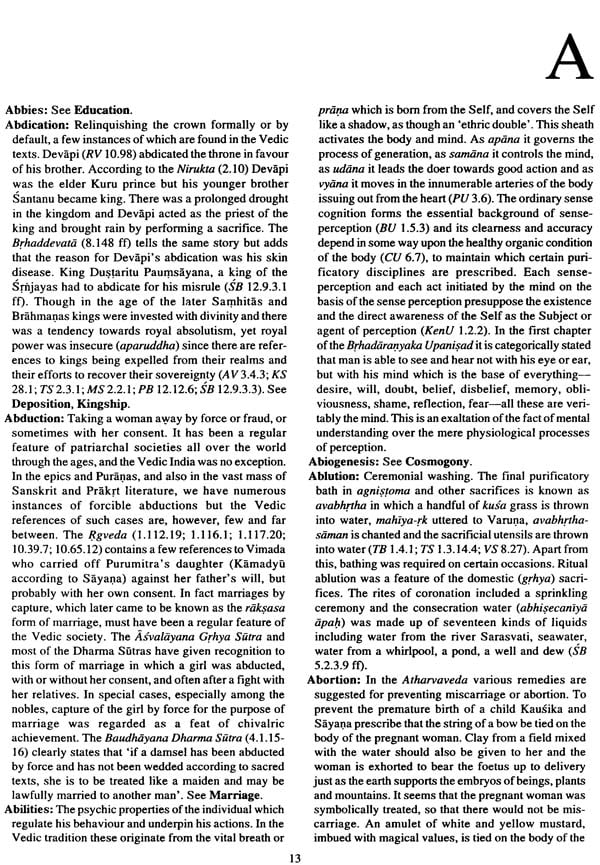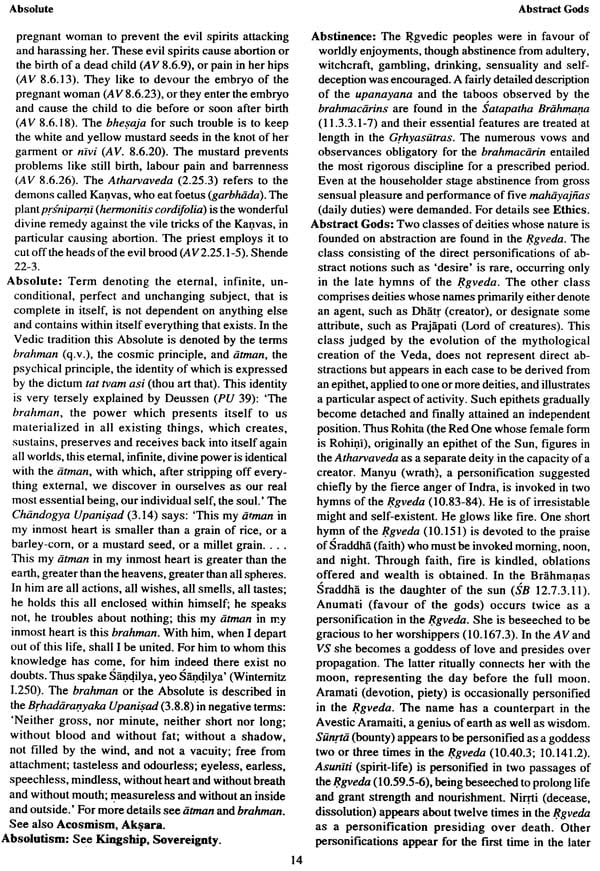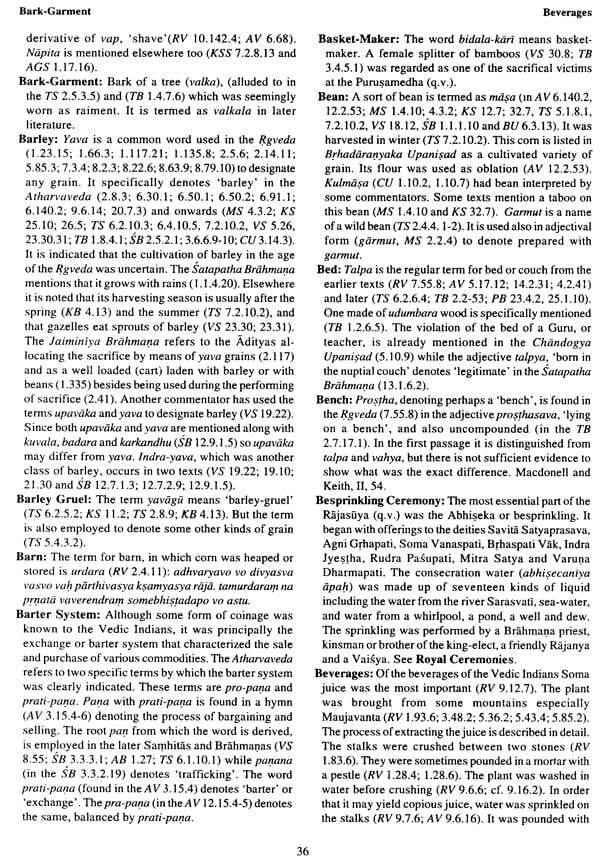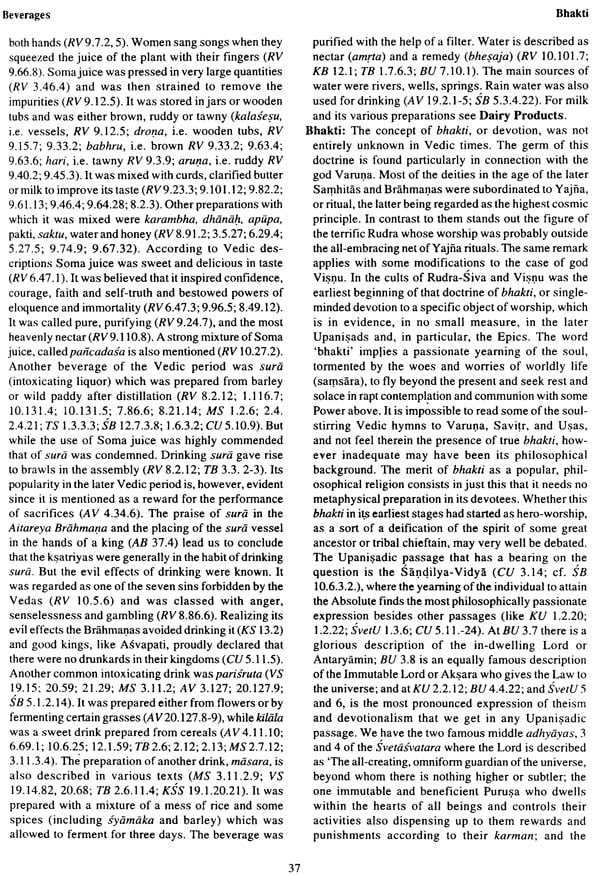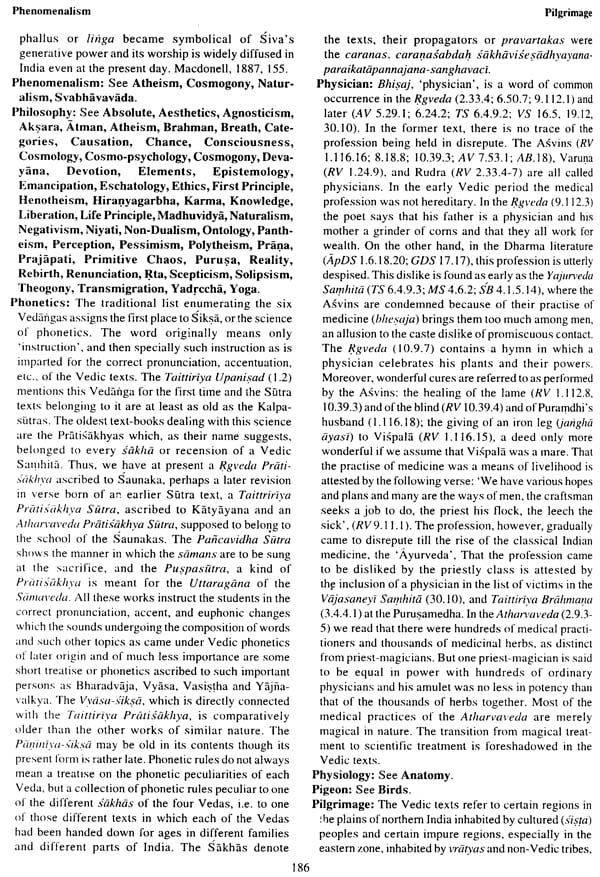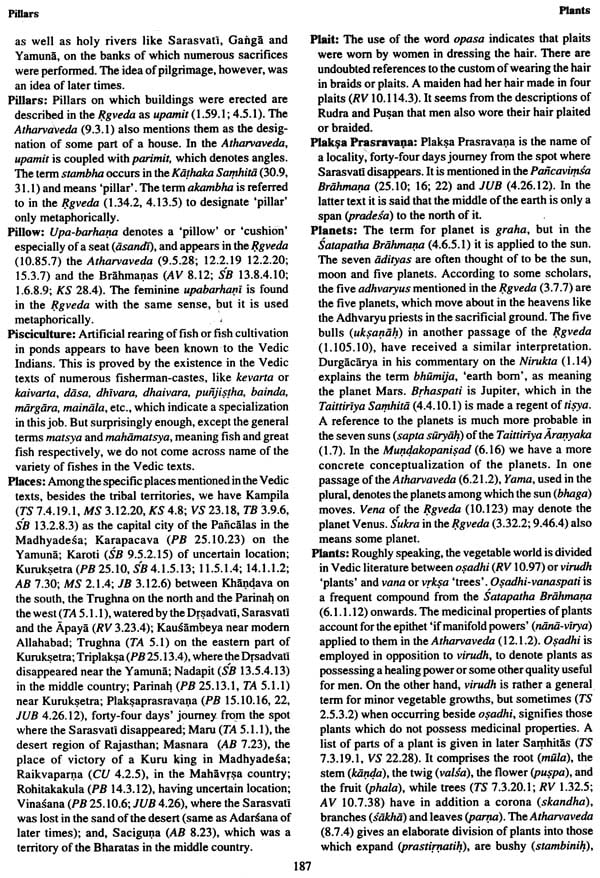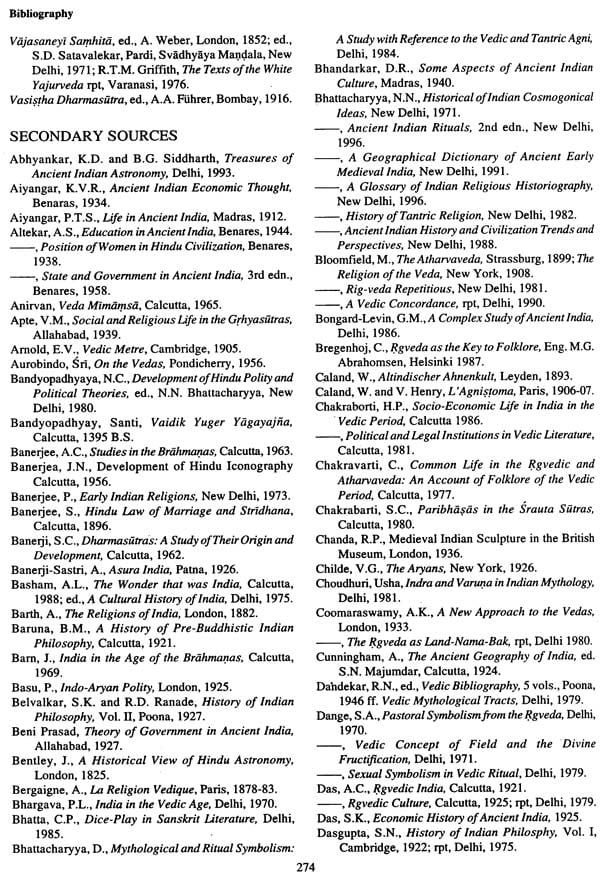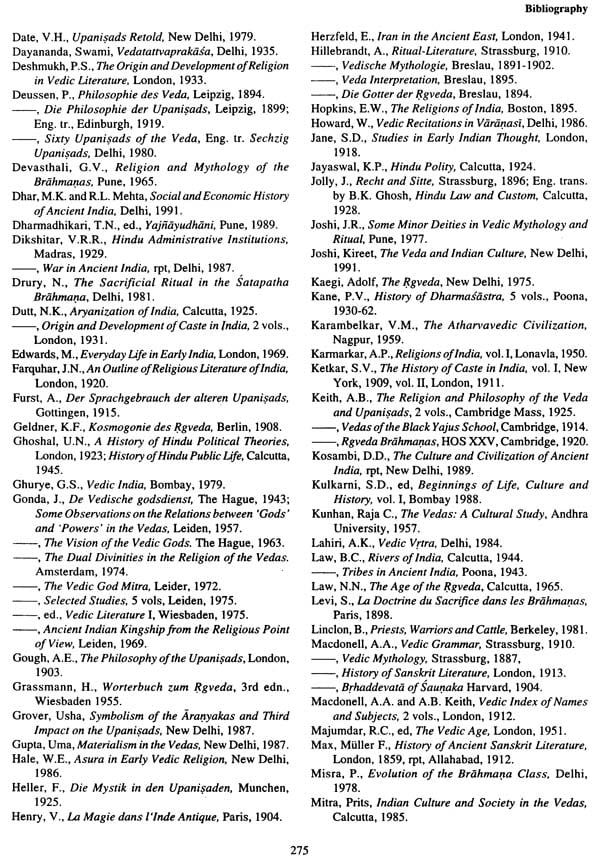
A Cultural Index to Vedic Literature
Book Specification
| Item Code: | NAZ426 |
| Author: | N.N. Bhattacharyya |
| Publisher: | Manohar Publishers and Distributors |
| Language: | English |
| Edition: | 2007 |
| ISBN: | 8173047324 |
| Pages: | 278 |
| Cover: | HARDCOVER |
| Other Details | 11.00 X 9.00 inch |
| Weight | 970 gm |
Book Description
The latter is a descriptive terminological glossary of Vedic antiquities, and as such can be used successfully only by those who have, to a certain extent, a comprehension of Vedic terms. The present volume contains subject wise entries which are expected to be of greater use to the readers.
As far as possible duplication with Vedic Index has been avoided. But wherever necessary abridged renderings of certain entries have been taken from it because for many entries it is impossible to add anything more to what has already been collected, classified and interpreted by MacDonnell and Keith. The diverse interpretations of the earlier scholars on entries pertaining to material culture, social institutions, economic conditions and related subjects have been retained in certain interesting cases but in other cases they have been replaced by modern views.
Many details about geographical and tribal proper names, and those of some of the Upanisadic thinkers whose views have relevance to the growth of subsequent Indian philosophical speculations, have been provided.
Entries on religion and philosophy, as also on ethical, aesthetic and other higher aspects of life have been given prominence in the volume.
The Index, drawing on a large body of literature/sources, provides very useful information on the social life, political and economic conditions, material culture, religion, mythology, art, medicine, science, technology and literature of the period making it a unique reference tool for researchers, teachers and students and general scholars alike.
The UGC visiting team, headed by Prof. S.D. Joshi, which recommended the establishment of the School of Vedic Studies in Rabindra Bharati University, suggested that the project of preparing a cultural index of Vedic literature should be undertaken by the School. Accordingly, the members of the School of Vedic Studies engaged themselves in compiling such a work under the directorship of Prof. Samiran Chandra Chakrabarti. Data was collected from the original Vedic texts mainly by the project assistants of the School; besides, I and Dr Pradyot Kumar Datta of the School of Vedic Studies and Dr Karunasindhu Das and Dr Taraknath Adhikari of the Dept. of Sanskrit also contributed -to the collection of data. There were four posts of project assistants at any given time, and the following scholars worked in these posts from time to time: Dipankar Mukhopadhyay (1990-1), Pranati Ghoshal (1990-3), Suparna Gupta (1990-3), Soma Basu (1990-2), Silpi Das (1991-2), Ashok Kumar Mahato (1993-4), Dr Rita Bhowmik (1993- 4), Bratati Goswami (1993-7), Sarbani Bhattacharya (1993-7), Jayanti Bhattacharya (1994-6), Parboty Chakraborty (1994-5), Ranjana Ganguli (1996-7), and Rapti Deb (1996-7). The service rendered by them is greatly appreciated.
It was considered desirable that the data thus collected be evaluated, arranged and edited in its historical perspective.
An opportunity presented itself when the late Dr Narendra Nath Bhattacharyya of the Dept. of Ancient Indian History and Culture, Calcutta University, joined the School of Vedic Studies as an Extension Lecturer in 1996. Dr Bhattacharyya was a reputed scholar, adept in both Sanskrit and History, with a good number of publications relating to ancient Indian history and culture to his credit. He was entrusted with the task of editing the data for the Cultural Index, and he devoted much time and energy to the work. The structure, treatment and method had all been designed by the editor. He was assisted by the project assistants at every stage.
In the past Dr N.N. Bhattacharyya was associated with us in various ways and the present work will remain as a token of his association with an interest in the programmers of the School of Vedic Studies. I deeply regret that he did not live to see the publication. We are grateful to him for the ungrudging service he rendered in bringing about the publication of the Index. Since he Was not able to read the proofs of his book it is possible that some errors which could have been avoided had he been able to do so still remain. In the absence of the editor, the proofs were corrected by Dr G.S. Mukherji and Dr Soma Basu to whom I am very grateful.
I take this opportunity to express my thanks to all those who contributed to the preparation of the Cultural Index in general and to Manohar Publishers & Distributors in particular for undertaking publication of this Index.
The title of the project is self-explanatory. It endeavors to present a conspectus of what is known as the Vedic age in Indian history by collecting from various texts relevant data pertaining to all aspects of Vedic thought and culture, analyzing and interpreting them in a historical perspective and arranging them under more than 1,000 topics in alphabetical order. It serves as a supplement to the celebrated Vedic Index (2 vols. London, 1912) by MacDonnell and Keith. The latter is a descriptive terminological glossary of Vedic antiquities, and as such can be used successfully only by those who have, to a certain extent, a comprehension of Vedic terms. The present volume contains subject wise entries which are expected to be of greater usefulness to the readers.
This does not, however, mean that terms representing names and subjects have been ignored. Abridged renderings have been given here from the Vedic Index itself, because for many entries it is impossible to add anything more to what has already been collected, classified and interpreted by MacDonnell and Keith. In the present volume royal and priestly lineages as well as personal names of kings, chiefs, sages and individuals, who form a considerable part ,of the Vedic Index, have been omitted. Geographical and tribal proper names, and those of some of the Upanisadic thinkers whose views have relevance to the growth of subsequent Indian philosophical speculations, have been retained and expanded with useful details. In fact, entries on religion and philosophy as also on ethical, aesthetic and other higher aspects of life have been given greater prominence in the present volume since the authors of the Vedic Index confined themselves to those aspects of religious activity that were inseparably connected with the social and political life of the age, such as priestly function, festivals, rituals of royal consecration and so forth.
As far as the entries pertaining to material culture, social institutions, economic conditions, and allied subjects are concerned, the diverse interpretations of the earlier scholars have been retained in certain interesting cases but in other cases these have been replaced by modem views. Numerous valuable works on various Vedic subjects have been published in recent years, from which much has been drawn in the present volume, especially when the topic is of scientific or technical nature or has intricate philosophical implications. The sources have been acknowledged at the end of each such entry.
A sincere attempt has been made to afford the reader a harmonious and well-thought-out picture of Vedic civilization. I am fully aware of the magnitude of the task and my own limitations in this regard. I am grateful for the cooperation of all my colleagues at the School of Vedic Studies: Sri Nabanarayan Bandyopadhyay, Dr Pradyot Datta, Dr Tarak Nath Adhikari and Dr Krishnakali Bhattacharya, all teachers of the Department of Sanskrit, Rabindra Bharati University; the project assistants Dr Soma Basu, Dr Rita Bhowmik, Sri Ashok Mahato, Ms Pranati Ghoshal, Ms Bratati Mukherjee, Ms Sarbani Bhattacharya, Ms Rapti Deb, Ms Ranjana Ganguli, Ms Silpi Das, Ms Suparna Gupta; and the attendent of the SVS Library, Mrs Sipra Daylight is also a matter of great satisfaction that my esteemed friend Sri Ramesh Jain of Manohar Publishers and Distributors has come forward and taken up the task of bringing out this volume.
Book's Contents and Sample Pages
